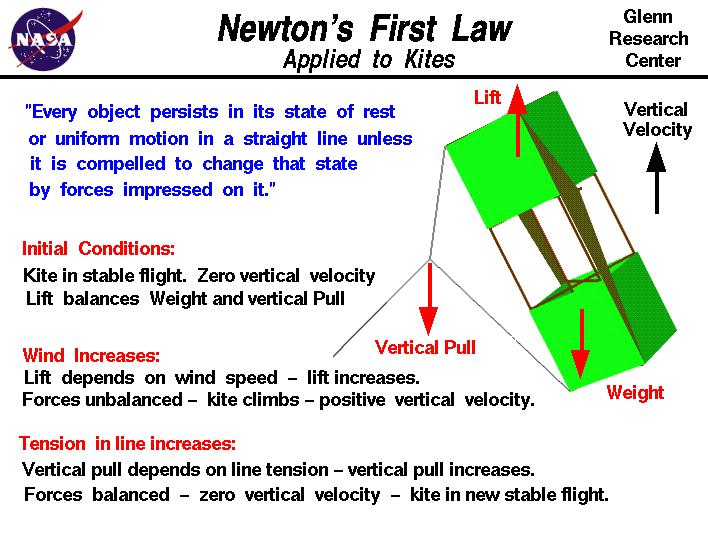
|
This page is intended for college, high school, or middle school students.
For younger students, a simpler explanation of the information on this page is
available on the
Kids Page.
|

Sir Isaac Newton first presented his three laws of motion
in the "Principia Mathematica Philosophiae Naturalis" in 1686. His first law
states that every object will remain at rest or in uniform motion in a straight
line unless compelled to change its state by the action of an external force.
This is normally taken as the definition of inertia. The key point here
is that if there is no net force resulting from unbalanced
forces acting on an object (if all the external forces cancel each other out),
then the object will maintain a constant velocity. If that velocity is zero,
then the object remains at rest. And if an additional external force is applied,
the velocity will change because of the force. The amount of the change in velocity
is determined by Newton's second law of motion.
A
kite flying through the
air is a good example of this principle. The
forces
acting on a kite in flight include the
weight,
the aerodynamic
lift and
drag,
and the tension in the
control line.
In stable flight, these forces are all balanced and the kite holds a fixed
altitude. The vertical velocity of the kite is zero.
If the wind increases slightly,
the lift and drag increase because the aerodynamic
forces depend on the square of the
velocity.
The forces on the kite are
no longer balanced and there is a net vertical force on the kite.
The kite moves vertically because the lift now exceeds the weight and
the vertical component of the tension in the control line.
As the kite climbs, the tension force increases because of increased lift and
drag.
The tension force is a
vector quantity
and we can
resolve
the force into a horizontal and a vertical pull.
As the tension force increases, the vertical
pull increases. Eventually a new balance
point is established in which the lift balances the weight and the vertical pull.
The kite then achieves a new stable flight condition at a slightly higher
altitude.
If the wind decreases, the lift, drag, and vertical pull all are decreased
and the kite achieves a new stable flight condition at a lower altitude.
Activities:
Guided Tours
-
 Newton's Laws of Motion:
Newton's Laws of Motion:

Navigation ..


- Beginner's Guide Home Page
|
